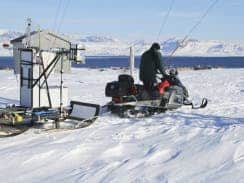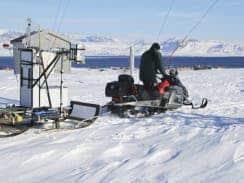
An international research team is in the land of snow and ice, in search of soot or black carbon, in an effort to judge whether or not it is responsible for the alarming rapid warming in the area lately. The research team includes scientists from Norway, Russia, Germany, Italy, and China, whose members are working from Norwegian islands inside the Arctic Circle, about halfway between Norway and the North Pole.
Scientists believe a thin layer of soot is causing the Arctic caps to absorb more heat, which is produced by vehicle engines, aircraft emissions, burning forests and wood- and coal-burning stoves.
“Carbon is dark in color and absorbs solar radiation, much like wearing a black shirt on a sunny day. If you want to be cooler, you would wear a light-colored shirt that would reflect the sun’s warmth,” said Tim Bates, a research chemist at NOAA’s Pacific Marine Environmental Laboratory (PMEL) in Seattle and co-lead of the U.S. component of the study.
“When black carbon covers snow and ice, the radiation is absorbed, much like that black shirt, instead of being reflected back into the atmosphere,” explained Bates.
The study’s goals are to coordinate more than a dozen research activities so they are done in tandem providing, for the first time, a vertical profile of black carbon’s movement through the atmosphere, its deposition on snow and ice surfaces, and its affect on warming in the Arctic.
“The Arctic serves as the air conditioner of the planet,” said Patricia Quinn of the National Oceanic and Atmospheric Administration (NOAA), and research chemist at Pacific Marine Environmental Laboratory (PMEL).
Heat from across the world moves towards the Arctic through air and water and at least some of that can radiate into space. This is while the ice and snow reflect the sun’s incoming heat to other parts of the Earth, making the poles cooling systems for the planet. Soot, however, could prove to be an extremely dangerous phenomenon.
In recent years, the Arctic has been warming more rapidly than other areas of the planet, a lot faster actually since over the past 100 years, the Arctic surface air temperature has increased twice as fast as the global average. It’s important to note that the “warming of the Arctic has implications not just for polar bears, but for the entire planet,” Quinn told the Associated Press (AP).
Authors of the study believe the Arctic warming would implicate the entire planet and that cutting carbon dioxide and other greenhouse gases would effectively resolve the issue. However, studies say that reducing the amount of short-lived pollutants, like soot, would be faster since greenhouse gases live much longer in the atmosphere.
The Norway research will continue through mid-May. The teams then will spend months analyzing their data and report the results at scientific meetings and in journals in the near future.









